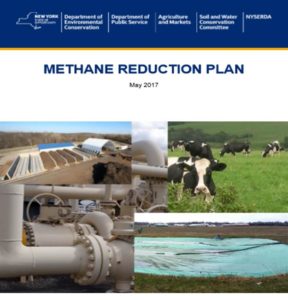In May New York State announced a Methane Reduction Plan (MRP) aimed at reducing methane (CH4) by 40% by 2030 and 80% by 2050. Going beyond the Federal EPA’s MRP and even California’s plan which largely target only Oil & Gas, they have focused on the 3 primary anthropogenic sources of CH4 in the State: Landfills (58%), Agriculture (22%) and Oil & Gas production and storage (11%). To help achieve the targeted reductions 25 separate actions have been proposed; 11 for Oil & Gas, 9 related to Landfill emissions and 5 for Ag.
I blogged about biochar & CH4 reduction potential more than 3 years ago and fortunately the research on this topic has continued apace. While biochar could potentially help mitigate certain negative environmental impacts of fracking, most of the research has focused on filtering the toxic water that results and not on reducing emissions. I confess this is not an area that I’ve delved into with any enthusiasm so there may be additional benefits related to using biochar on the fracking front.
Landfills and agriculture, however, are another story. Biochar could potentially play a role in four of the nine proposed landfill related activities which have been split into two separate categories: 1) diverting organics to help reduce future emissions (#12 – 14) and 2) reducing current emissions (#15 – 19). While there is a heavy emphasis on diverting to food banks and anaerobic digesters, this isn’t always a viable option given distances to facilities nor is all food waste viable for either human or AD consumption. Carbonizing food waste may be a much more attractive and CH4 (not to mention other GHGs) reducing option. The focus on reducing current emissions is largely on CH4 reporting & capture but #17 goes beyond that to ‘identify best practices, in conjunction with evaluations of potential revisions to regulations, to reduce CH4 emissions and diminish odors). Utilizing biochar on landfills, either for daily cover or during the capping process, has shown promising results both from a CH4 and odor reduction perspective. Recent research has shown that blending char with soil, versus using layers of pure biochar, improved removal efficiency. Other research suggests that biochar pore sizes may not be small enough to remove CH4, so more research is definitely needed.
But it is the agricultural front that I believe holds the most promise for biochar mitigation strategies. The NYS plan has articulated mitigation strategies for manure management (#20), enteric emissions (#21), monitoring & reporting (#22 – 23) as well as soil carbon sequestration (#24 – 25). Claudia Kammann, a fantastic biochar researcher from Germany, and 14 others recently published an (open source) article on “Biochar as a tool to reduce the agricultural greenhouse-gas burden – knowns, unknowns and future research needs”. This paper looks at the current state of biochar research in terms of N2O and CH4 soil emission mitigation potential, the impact of using biochar as a composting additive on CH4 & N2O emissions, and its use in animal husbandry in terms of both its use as a feed additive and carbonizing manures via pyrolysis. While the mechanisms behind biochar’s ability to mitigate GHG emissions are still under review, the most relevant characteristics for biochars to optimize different end goals still needs significant research. Overall though, there are enough promising indications to warrant more funding for this type of research, especially in light of the fact that GHG mitigation is only one of the potential benefits of using biochar. Soil health, yield improvement, reduced water needs and other potential benefits can also be realized in many scenarios.
The research paper presented some ‘back of the envelope’ calculations for adding 1% biochar (see Table 1) to the daily feed intake of the global livestock population as a means of sequestering carbon. As the carbon does not biodegrade in the digestive track but is excreted in the manure, nearly 400 Mt/yr of CO2e could be sequestered in this manner – and that doesn’t even begin to address the potential CH4 mitigation potential from enteric emissions or N2O emissions from manure or the improved animal health or the accelerated feed conversion impacts!
I would encourage all five of the entities [Department of Environmental Conservation (DEC), Department of Public Service (DPS), Department of Agriculture & Markets (DAM), Soil & Water Conservation Committee (SWCC) and Energy Research & Development Authority (NYSERDA)] tasked with working on further refinements and funding proposals to review the potential of biochar to not only help reduce emissions, but build a thriving biochar industry in NYS that can help resolve other issues that are contributing to environmental degradation.



